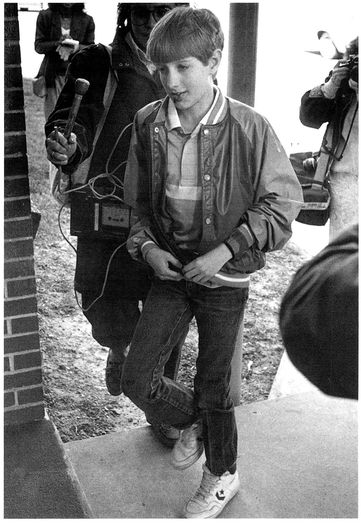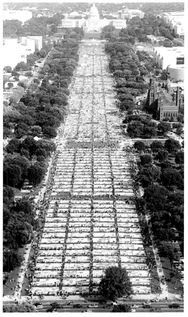“People would get up and leave, so they would not have to sit anywhere near me.”
Kokomo, Indiana, 1984—1986
Around 1980, Americans encountered a mysterious new disease that seemed to make it very hard for victims to recover even from simple colds and flu. Researchers could find no cure. It was named Acquired Immune Deficiency Syndrome, or AIDS. Later research found it to be a disease of the blood, caused by HIV, which stands for Human Immunodeficiency Virus. It attacks the body’s immune system—weakening the body’s ability to combat infections. The virus is transmitted through contact with the bodily fluids of an infected person or through medical products that contain blood. An Indiana boy named Ryan White got AIDS in 1984, when he was thirteen. He suffered from hemophilia, which meant that his blood did not clot properly, and he was infected with HIV from contaminated blood. Like many throughout history infected with serious diseases, Ryan found that once word got around, many people were afraid to be near him. He described what his life was like at school when he spoke before the Presidential Commission on AIDS in Washington, D.C., in 1988.
SOME FACTS ABOUT HIV/AIDS
• You can’t get it from hugging, coughing, sneezing, sweating, or through sharing food or eating utensils.
• You can’t get it from toilet seats or drinking fountains.
• You can’t get it from mosquitoes or other insects.
• It can be transmitted by having sex with an infected person, or by sharing needles or syringes with an infected person.
• It can also be transmitted through a transfusion of contaminated blood (which is why hospitals carefully monitor their blood supplies).
PANDEMICS
AIDS is a pandemic, or a worldwide health crisis. By 1997, AIDS had killed twenty-two million people, with many more millions infected. New medicines and treatments have slowed the virus in some parts of the world, but there is still no cure at this writing.
Some other important pandemics:
• The Justinian Plague. Plague is carried by a bacteria that lives inside rats and fleas. This epidemic arose near the Nile River and wiped out more than half the people in the world between A.D. 541 and 700.
• The Black Death. Another outbreak of plague killed one-fourth of the population of Europe between 1347 and 1352.
• Smallpox. Caused by a virus that spreads from human to human through the air. During the Middle Ages, smallpox wiped out hundreds of millions in Europe, Asia, and Africa, and then was carried to the New World by European explorers, where it killed millions of Native Americans.
• The Spanish flu. This flu killed twenty million people throughout the world in less than a year in 1918.
“I came face to face with death at thirteen years old. I was diagnosed with AIDS: a killer … Given six months to live and the fighter that I am, I set high goals for myself. It was my decision to live a normal life, to go to school, be with my friends, and enjoy day to day activities. It was not going to be easy.
“The school I was going to said they had no guidelines for a person with AIDS … We began a series of court battles for nine months, while I was attending classes by telephone. Eventually, I won the right to attend school, but the prejudice was still there. Listening to medical facts was not enough. People wanted one hundred percent guarantees. There are no one hundred percent guarantees in life, but concessions were made by Mom and me to help ease the fear. We decided to meet them halfway. [This included]:
• Separate restrooms
• No gym
• Separate drinking fountains
• Disposable eating utensils and trays …
“Nevertheless, parents of twenty students started their own school. They were still not convinced. Because of the lack of education on AIDS, discrimination, fear, panic, and lies surrounded me.
1. I became the target of Ryan White jokes.
2. Lies [circulated] about me biting people
3. spitting on vegetables and cookies [and]
4. urinating on bathroom walls.
5. Some restaurants threw away my dishes.
6. My school locker was vandalized inside and folders were marked FAG and other obscenities.
“I was labeled a troublemaker, and my mom an unfit mother, and I was not welcome anywhere. People would get up and leave, so they would not have to sit anywhere near me. Even at church, people would not shake my hand.
“This brought in the news media, TV crews, interviews, and numerous public appearances. I became known as the AIDS boy. I received thousands of letters of support from all around the world, all because I wanted to go to school … It was difficult, at times, to handle, but I tried to ignore the injustice, because I knew the people [at school] were wrong. My family and I held no hatred for those people because we realized they were victims of their own ignorance. We had great faith that, with patience, understanding, and education, my family and I could be helpful in changing their minds and attitudes around.
“Financial hardships were rough on us, even though Mom had a good job at General Motors. The more I was sick, the more work she had to miss. Bills became impossible to pay. My sister, Andrea, was a championship roller skater who had to sacrifice too. There was no money for her lessons and travel. AIDS can destroy a family if you let it, but luckily for my sister and me, Mom taught us to keep going. Don’t give up, be proud of who you are, and never feel sorry for yourself …
“At the end of the [1986—1987] school year my family and I decided to move to Cicero, Indiana. We did a lot of hoping and praying that the community would welcome us, and they did. For the first time in three years, we feel we have a home, a supportive school, and lots of friends. I am a normal happy teenager again. I have a learner’s permit. I attend sports functions and dances. My studies are important to me … I’m just one of the kids, and all because the students of Hamilton Heights High School listened to the facts, educated their parents, and believed in me. I believe in myself as I look forward to graduating from Hamilton Heights High School in 1991.”
Fourteen-year-old Ryan White walks into a middle school in Clinton, Indiana. School officials had told him he could not enter the building because he had AIDS, but the Whites obtained a judge’s order that overruled the school.

The AIDS Memorial Quilt on display in Washington, D.C., in 1992. Each three-by-six-foot panel commemorates a person lost to AIDS. The quilt covers an area larger than eleven football fields.

Ryan died on April 8, 1990. He became well known throughout the world for his courage and positive attitude. The Ryan White Foundation was established in his name to “increase awareness of personal, family, and community issues related to HIV and AIDS.”